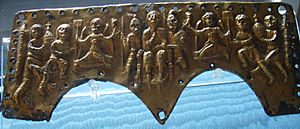Agilulf facts for kids
Quick facts for kids Agilulf |
|
|---|---|
| King of the Lombards | |

Gilt bronze forehead plate of a lamellar helmet depicting the coronation of King Agilulf, found at Valdinievole, now in the Bargello National Museum, Florence.
|
|
| Reign | 590-616 |
| Predecessor | Authari |
| Successor | Adaloald |
| Born | c. 555 |
| Died | April 616 Milan, Neustria Lombard Kingdom |
| Spouse | Theodelinda |
| Issue | Adaloald Gundeberga |
| Religion | Arianism |
Agilulf (born around 555 – died April 616), also known as the Thuringian, was an important king of the Lombards. He ruled from 591 until his death. He was a relative of the previous king, Authari. Agilulf was chosen to be king with the help of Authari's widow, Queen Theodelinda, whom he later married.
Contents
Becoming King of the Lombards
Agilulf was a duke from Turin. He was part of a group of Thuringians who joined the Lombards. The Lombards were a Germanic people who had settled in Italy.
He became king in November 590. A special ceremony took place in Milan in May 591. During this ceremony, Lombard warriors raised him on a shield. This was a traditional way to show he was their new leader.
Agilulf's Religious Journey
Agilulf was first a follower of Arianism. This was a type of Christianity different from what the Pope followed. His wife, Theodelinda, was a Catholic. To make her happy and to bring his people together, Agilulf was baptized.
In 603, influenced by his wife, he decided to become a Catholic. He also had his son, Adaloald, baptized as a Catholic. Agilulf and Theodelinda built a important church in Monza. This church still holds the famous Iron Crown of Lombardy. Agilulf also had his own crown. It was called "king of all Italy," showing how he saw his power.
Wars, Truces, and Peace
Agilulf's long rule brought more peace to the Lombard kingdom. He stopped fighting with the Franks. The Frankish king, Guntram, who had been a peacemaker, died in 592. After his death, the Franks had their own civil wars. This meant they couldn't attack the Lombards.
In 598, Agilulf made a truce with the Papacy. The Papacy is the government of the Pope. This truce ended many years of Lombard attacks near Rome. Agilulf then focused on fighting the Byzantine Empire. The Byzantines were another powerful empire in the region.
Agilulf made his kingdom stronger. He took cities like Sutri and Perugia from the Byzantines. He also kept good relationships with the Bavarians. He fought against the Avars and Slavs. In 598, he made a truce with the Byzantine emperor, Maurice. This was helped by Pope Gregory the Great.
However, the truce was broken in 599. A Byzantine leader kidnapped Agilulf's daughter. This started another war. In 602, the Byzantines lost Padua to Agilulf. This city was important because it cut off Mantua, which also fell to Agilulf.
In 607, Agilulf joined an alliance with other kings. This included the king of the Visigoths. They planned to fight against a Frankish king. We don't know much about the battles, but they likely happened near Narbonne.
Later Reign and Legacy
In 605, the Byzantine emperor Phocas recognized Agilulf as king. Phocas even paid him a tribute and gave him some towns. The Byzantines then focused on wars in the East. This gave Agilulf peace for his last ten years as king.
He had to stop some small rebellions. The Avars also continued to invade Friuli, where they killed a duke in 610. But overall, his reign ended peacefully. Agilulf died in 616, after ruling for more than 25 years.
His son, Adaloald, became king after him. Adaloald was still young, but he had been prepared to rule. Agilulf also had a daughter named Gundeberga. She later married Arioald, who also became a king.
See also
 In Spanish: Agilulfo para niños
In Spanish: Agilulfo para niños

